
My introduction to the Midland & South Western Junction Railway came at an early age - I was two weeks old! Oddly enough, I don't remember the experience but apparently I was transported from the maternity hospital in Cirencester to our then home in Cricklade via the M&SWJR. By the time I was two my mother had discovered that crossing a railway bridge without allowing me to see a train was a guarantee of a screaming fit lasting at least an hour. Life was made more difficult for her by the fact that we lived in a small country town where trains were not noted for their frequency.
.From the age of three I lived in a house that backed onto the Midland & South Western Junction Railway at Cirencester and the following notes are the result of my interest in that line over the past 50 years. In recent times the line has emerged from obscurity and is now well-documented, as I have shown in the bibliography below. When I first knew it there only a few articles in the railways magazines and the books of Ahrons and C.Hamilton Ellis. However it is to this small and often impecunious line, owning less than 30 locomotives, that my allegiance has always been; I do have a sneaking regard for the Highland and Great North of Scotland Railways as well and, living only fifteen miles from Swindon, I could not help but be influenced by the Great Western
On this site I have published photographs that I have taken of the remains of the MSWJR and also illustrated some of the memorabilia in my collection.
I moved into a house backing onto the rundown remains of the M&SWJR in 1952. The line had had its heyday in the period before the First World War and thereafter suffered through chronic lack of investment (and interest) once it fell into the hands of the GWR at the grouping in 1923. When I first knew it in BR days there was still a reasonable amount of traffic, the best passenger train being hauled by a 'Manor' class 4-6-0 and the rest by '6300' 2-6-0s. Freight was in the hands of the '6300's, '2200' 0-6-0s, '4500' 2-6-2Ts and the ubiquitous 0-6-0PTs. Our lives were governed by trains, bedtime being signalled by the main north-bound passenger train of the day passing the house at 1930, hauled by the likes of 7808 'Cookham Manor' or 7810 'Draycott Manor'. At about 2330 most nights a long banana train made its way north from Southampton Docks - we rarely saw these but the returning empties could be seen coming south during the day, if you were off school. By the time I reached secondary school age and regained my view of the railway which ran on an embankment across the bottom of the playing field, the service had shrunk to a single passenger train each way (usually hauled by ex-Southern Railway 'N' or 'U' class 2-6-0s) and a daily freight behind a 0-6-0PT. One of the tank locomotives seen on this service, and also a regular at the old GWR station in the town, was 4651 and I bought one of its cab-side number plates from Swindon Works in 1966

My friend, Jim Pole, had an interest in signalling and he managed to interview an old M&SWJR employee, Ernie Oldcorn, who produced a plan of the signalling at Cirencester following the reduction of the line to single track in the 1920s. The accuracy of the placing of ground signals is open to doubt

The junctions on the southern half of the line, from an Railway Clearing House map of 1906
 |
Savernake & Marlborough |
|
|
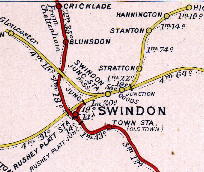 |
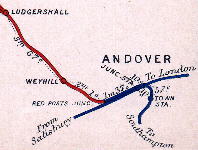 |
Andover |
Another form of diagram for the MSWJR showing a schematic of the line, first drawn in August 1954 when the line was in British Railways hands. It show each station on the section between Swindon and Savernake with its track layout, including catch points and ganger sections for maintenance. I suspect that this is a later edition of the original 1954 plan as only some of the trackwork at Swindon Town has been left as a solid line, the rest, other than the main line at Savernake LL has been shown dashed. Perhaps this indicates that the rest is out-of-use. Also just below the 32M 57c marker on the Rushey Platt curve, a pair of crossovers have been pencilled in.
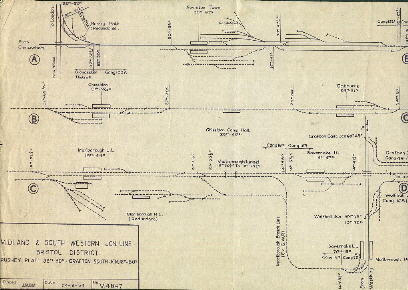
The M&SWJR provided a useful through route between the North of England and the South Coast. Although never actively promoted after its takeover by the Great Western in 1923, this GWR name board, photographed at Winchcombe Railway Museum, does show the continuation of at least one of the through services that the MSWJR developed.

A MSWJR share certificate, for the Swindon, Marlborough and Andover Section,dated 1920. The impressed company stamp can be seen on the left, cut by the cancellation marks
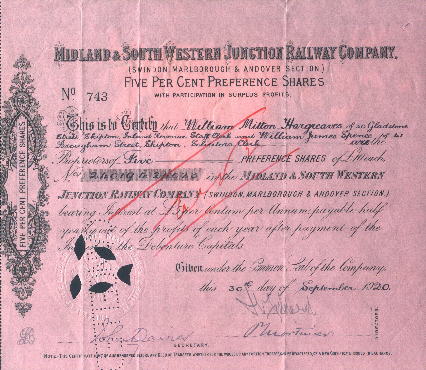
One of my brothers worked for a company making resin copies of artefacts. One of their commissions was for the Swindon Railway Museum and this is the representation of the company seal that he made
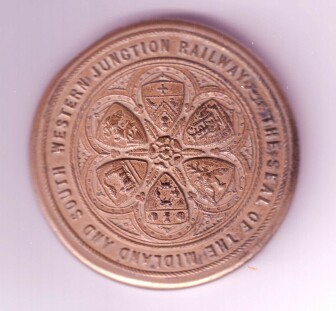
Memorabilia associated with the M&SWJR is thin on the ground. Fortunately I was recently given a clock which was used at Cirencester. It is made of brass and probably originally travelled in a box for protection. It came to me from a friend of an ex-M&SWJR inspector called Henry Robinson. It is a simple turn-of-the-century clock with no external markings; the provenance is inside, on the back plate, where the words 'Cirencester Works' are written in ink and 'Loco Depot, Cirencester' scratched into the brass.
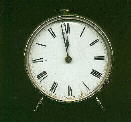 |
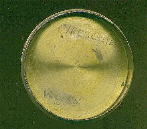 |
Another very small item of M&SWJR memorabilia that I possess is a perforated stamp (known in philatelical circles as a perfin, short for PERForated INitials). This is a standard Queen Victoria revenue stamp perforated with the initials M S W J in a square. It is postmarked Cirencester, date unknown. The idea of the perforations was to help prevent the theft of stamps held by the company
 |
The company also issued its own stamps. Below is a 4d letter stamp dating from around 1920
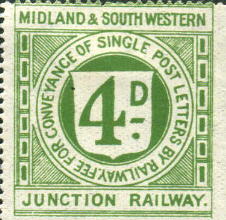 |
0-6-0 number 28 at Southampton West. It was published by E. Pouteau of Gray's Inn Road, London and is postally unused.
 |
This postcard was published by Valentines and shows Swindon Station. It was posted in September 1911
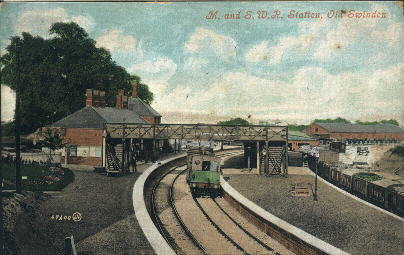 |
Ludgershall Station, published by Yates Stores, Ludgershall, postally unused
 |
A postcard of Chiseldon Station published by Hooper of Swindon. Postally used, possibly in 1912
 |
Another postcard of Chiseldon Station published by Tomkins & Barrett of Swindon. Postally used, date unknown
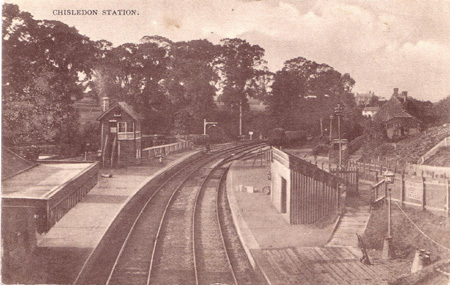 |
A photograph showing cavalry troops waiting on Ludgershall station as a train approaches, date unknown
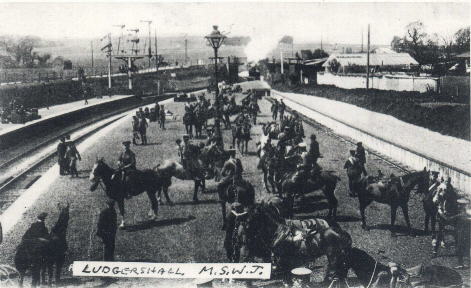 |
A recent acquisition has been an MSWJR timetable dated August 1st 1915. It is a single sheet of thin card printed on both sides, as befits its wartime status. I have provided a scan of both sides at high resolution (about 1.1MB each)for those interested in the details of the services.
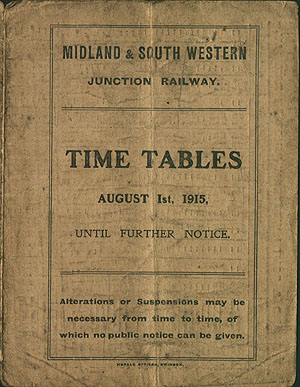
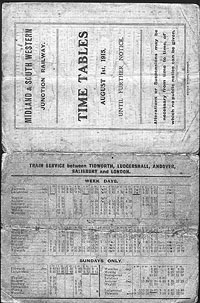 |
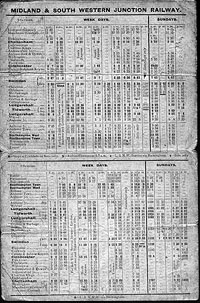 |
A timetable from early BR days, dated September 1st-19th, 1953, taken from The Swindon Advertiser ABC Timetable

The M&SWJR was an amalgamation of two lines, the Swindon, Marlborough & Andover Railway and the Swindon & Cheltenham Extension. The SM&AR had opened in 1884 but even before this, schemes were afoot to connect this line with Cheltenham. The Act of 1881 included provision not only for the extension to Cheltenham but also for a branch to connect Cirencester with the East Gloucestershire Railway at Fairford and a curve connecting the SM&AR to the GWR, west of Swindon Junction.
 |
The East Gloucestershire had started as an ambitious scheme connecting Cheltenham directly to Oxford,as shown in the map from its Parliamentary Bill but its efforts had come to naught and it languished as a minor country branch line. The connection to Cirencester would have given it more purpose but probably only a little more traffic, although it would have shortened the distance between Cheltenham and London. When the Cirencester-Fairford branch fell by the wayside, the M&SWJR provided a steam driven motor van service with a passenger carrying trailer in its place
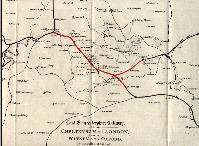 |
| A GWR third class ticket from Cirencester (Watermoor) to Foss Cross, dated March 10th 1937 |  |
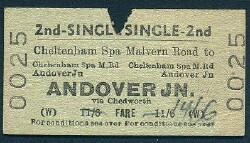 |
A single ticket, Cheltenham Spa Malvern Road to Andover Junction via Chedworth, dated 29th April 1961. |
| An unused season ticket of the GWR era from Withington station |  |
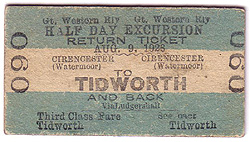 |
GWR third class Half Day Excursion return, Cirencester Watermoor to Tidworth dated August 9th 1928 |
| A GWR luggage label for use to a popular (or perhaps not if you were a squaddie off to camp) destination | 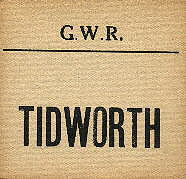 |
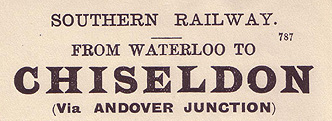 |
A Southern Railway luggage label to another destination on the former MSWJR which possessed an Army camp |
A couple of freight labels for CATTLE and EMPTY
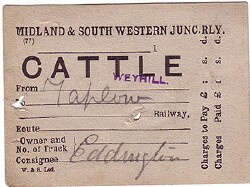 |
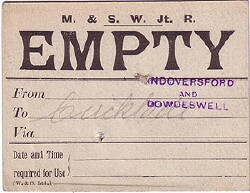 |
The best site by far, in my opinion, is Swindon's Other Railway. This site is informative and comprehensive and also provides a number of links to other sites with M&SWJR connections. The photographs are excellent
Books about the MSWJR
The Midland & South Western Junction Railway, Colin G Maggs, David & Charles, Newton Abbot, 1967
The Midland & South Western Junction Railway, Brian Bridgman & Mike Barnsley, Chalford Publishing, Chalford, 1994, ISBN 0754-0016-9
A M.& S.W.J.R. Album, Vol.1, 1872-1899, David Barrett, Brian Bridgman & Denis Bird, Redbrick Publishing, Swindon, 1981, ISBN 0-9507182-2-X
Swindon's Other Railway, The Midland & South Western Junction Railway, 1900-1985, , David Barrett, Brian Bridgman & Denis Bird, Redbrick Publishing, Swindon, 1985, ISBN 0-948263-01-6
The Midland & South Western Junction Railway, T.B.Sands, The Oakwood Press, 1959
Midland & South Western Junction Railway, Vol.1, David Bartholomew, Wild Swan Publications, Upper Bucklebury, 1982, ISBN 0-906867-08-8
Midland & South Western Junction Railway, Vol.2, Locomotives, Mike Barnsley, Wild Swan Publications, Didcot, 1991, ISBN 0-906867-96-7
Midland & South Western Junction Railway, Vol.3, Carriages & Wagons, Mike Barnsley, Wild Swan Publications, Didcot, 1995, ISBN 1-874103-25-9
Midland & South Western Junction Railway Timetables, 1915, Reprint, Oxford Publishing, Cowley, Oxford
Cheltenham to Andover, Vic Michell & Keith Smith, Middleton Press, 2000, ISBN 1 901706 43 5
Books with substantial sections on the MSWJR
Great Western Absorbed Engines, J.H.Russell, Oxford Publishing, 1978, ISBN 0-902888-74-9
The Locomotives of the Great Western Railway, Part 10, Absorbed Engines, Railway Correspondence & Travel Society, 1966
Gloucestershire Railways in the Twenties, Humphrey Household, Alan Sutton, Gloucester, 1984, ISBN 0-86299-197-8
Cotswold Memories, Ron Pigram & Dennis F. Edwards, Unicorn Books, Paddock Wood, 1990, ISBN 1-85241-002-7
Great Western Way, J.N.Slinn, Historical Model Railway Society, Frome, 1978, ISBN 0-902835-03-3
GWR Absorbed Coaching Stock, 1922/3, E.R.Mountford, Oakwood Press, Tarrant Hinton, 1978
Locomotive & Train Working of the Latter Part of the Nineteenth Century, Vol.4, E.L.Ahrons, Heffer, Cambridge, 1952
Copyright © 2004 -
David J Cannings-Bushell
All Rights Reserved
Last updated August 10th 2004
Webmaster: David J Cannings-Bushell - dave@canbush.com